NCERT Solutions for Class 6 Maths Chapter 5 Understanding Elementary Shapes Ex 5.1 Ncert Solutions Chapter 5 Understanding Elementary Shapes Ex 5.1 Class 6 Maths Chapter 5 Exercise 5.1 Ncert Class 6 Maths Chapter 5 Exercise 5.1
NCERT Solutions for Class 6 Maths Chapter 5 Understanding Elementary Shapes Ex 5.1
Question 1.
What is the disadvantage in comparing line segments by mere observation?
Solution :
Sometimes the difference in lengths betweenthe two line segments is not obvious. So, we are not always sure about our usual judgment.
Question 2.
Why is it better to use a divider than with a ruler, while measuring the length of a line segment?
Solution :
There may be errors due to the thickness of the ruler and angular viewing by using a ruler. These errors are eradicated by using a divider. So, it is better to use a divider, than a ruler, while measuring the length of a line segment.
Question 3.
Draw any line segment, say AB¯¯¯¯¯¯¯¯. Take any point C lying in between A and B. Measure the lengths of AB, BC and AC. Is AB = AC + CB? [Note : If A, B, C are any three points on a line such that AC + CB = AB, then we can be sure that C lies between A and B.]
Solution :
![]()
![]()
Length of AB = 7 cm
Length of BC = 3 cm
Length of AC = 4 cm
AC + CB = 4 cm + 3 cm = 7 cm
But AB = 7 cm
So, AB = AC A- CB.
Question 4.
If A, B, C are three points on a line such that AB = 5 cm, BC – 3 cm and AC – 8 cm, which one of them lies between the other two?
![]()
![]()
Solution :
AB + BC = AC, so, the point B lies between the point A and point C.
Question 5.
Verify, whether D is the mid-point of AG.
Solution :
AD = AB + BC + CD = 3 units
DG = OE + EF + FG = 3 units
∴ Yes ! D is the mid-point of AG.
![]()
![]()
Question 6.
If B is the mid-point of AC¯¯¯¯¯¯¯¯ and C is the mid-point of BD¯¯¯¯¯¯¯¯, where A, B, C, D lie on a straight line, say why AB = CD ?
Solution :
![]()
![]()
∴ B is the mid-point of AC¯¯¯¯¯¯¯¯
∴ AB = BC …(1)
∴ C is the mid-point of BD¯¯¯¯¯¯¯¯
∴ BC = CD … (2)
In view of (1) and (2), we get AB = CD.
Question 7.
Draw five triangles and measure their sides. Check in each case, if the sum of the lengths of any two sides is always less than the third side.
Solution :
(i) AB = 3.7 cm
BC = 3 cm
AC = 3.8 cm
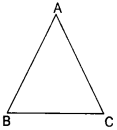

Clearly, AB + BC > AC
BC + AC > AB
AC + AB > BC
(ii) AB = 3 cm
BC = 3 cm
CA = 3 cm
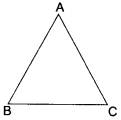

Clearly, AB + BC > AC
BC + AO AB
AC + AB > B C
(iii) AB = 4 cm
BC = 3 cm
AC = 5 cm
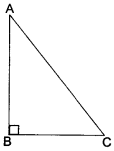

Clearly, AB + BC > AC
BC+ AC > AB
AC + AB > BC.
(iv) AB = 2 cm
BC = 2 cm
AC = 2.8 cm
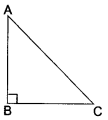

Clearly, AB + BC > AC
BC + AC > AB
AC +AB> BC
(v) AB = 3 cm
BC = 4 cm
CA = 3 cm
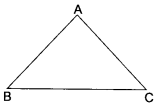

Clearly, AB + BC > AC
BC + AC> AB
AC + AB> BC
In each case, we observe that the sum of the lengths of any two sides is always greater than the third side.
